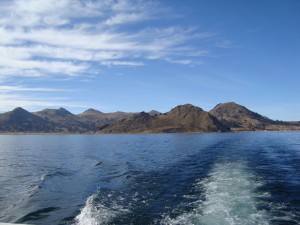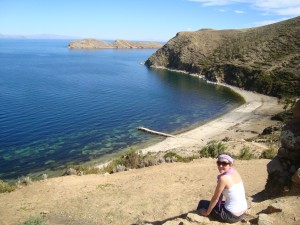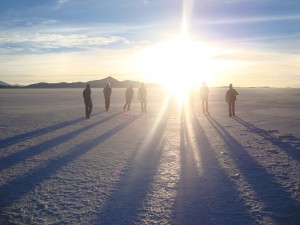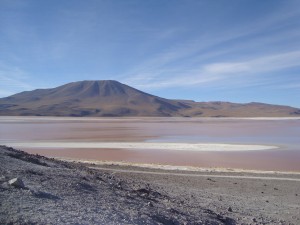Copacabana is a small, laid back town nestled between browny-green hills on the shore of Lago Titicaca, one of the highest navigable bodies of water in the world, which straddles the Bolivia/Peru border. It´s probably not the one eulogised by Barry Manilow but has a real friendly, relaxed vibe and is a good place to dry out after a couple more nights at Loki, La Paz. It’s also the ideal base from which to explore the Bolivian portion of Lake Titicaca, namely the Isla del Sol.
We paid around 2 pounds for a 2-hour boat trip to the Isla del Sol, according to Incan mythology the birthplace of the sun itself and the provenance of the Incan race. On the way we got chatting to some Bolivian women from Santa Cruz who, on hearing that we’d bought no food, gave us half of theirs! What generosity!
It’s easy to see why the Incas attach such significance to this place, it is so serenely beautiful; peacefully picturesque. The best way to describe it is a series of rocky hills rising out of the tranquil navy blue waters of the lake – some with ragged pre-Incan terracing carved into them that afford plateaus for growing crops or grazing donkeys and pigs – encompassing azure bays with the rugged ice-rendered Andes looming above the lake along the horizon. Ramshackle mud-brick villages lined the trail we huffed and puffed along, partitioned by precarious rock walls, the locals herding llamas or pigs or selling handicrafts.
We trekked to the ruins of an Incan village. The roofs had long gone but the narrow corridors and dark ante-chambers remained, marvellous in that they’re still standing simply by virtue of being stacked propitiously (no mortar). We had lunch (courtesy of the Bolivian women on the boat!) in the ruins with our legs dangling over a deserted turquoise bay before the boat took us to the Southern part of the island. Here we heard, booming away in the mountains, the deep bass line of loud music – which seemed a bit incongruous on this peaceful little island. We panted our way up some 500 steps to find that there was a Bolivian wedding in progress; a typically colourful affair with everyone merrily dancing away, some sort of karaoke, and people falling over drunk, peeing indiscriminately!
We headed back to Copacabana to spend our last Bolivianos before crossing the border into Peru (our last land border crossing…)




